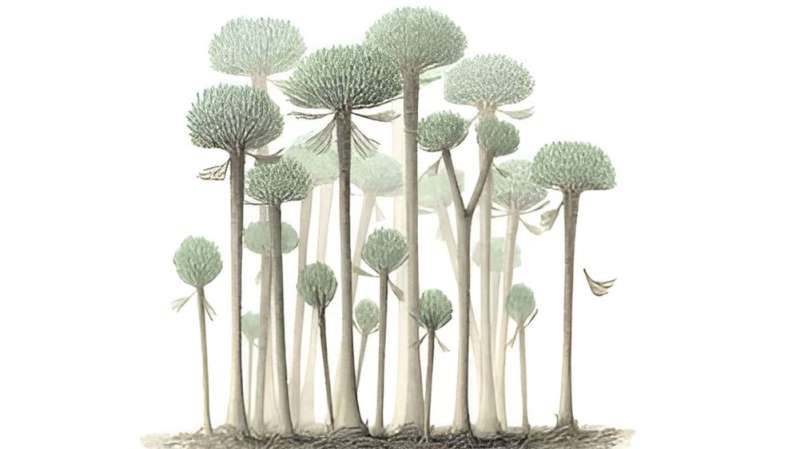This article has been reviewed according to Science X's editorial process and policies. Editors have highlighted the following attributes while ensuring the content's credibility:
fact-checked
peer-reviewed publication
trusted source
proofread
Earth's earliest forest revealed in Somerset fossils

Scientists have discovered remnants of the Earth's oldest fossil forest on the north coast of Devon and Somerset in the U.K. The trees, which are about 390 million years old, are thought to have grown as part of an extensive forest covering the east coast of the Old Red Sandstone continent—part of Europe at that time.
This makes the Somerset forest 4 to 5 million years older than the previous record holder at Cairo, New York, in the U.S.
Discovered by researchers from Cambridge University and identified at Cardiff University, the fossils show incomplete trunks up to 2 meters long, together with small branches, of a pioneering type of tree called cladoxylopsids.
Cladoxylopsids dominated terrestrial ecosystems for a period of about 5 million years before the advent of more modern woody trees about 385 million years ago, according to the team.
Their findings, presented in the Journal of the Geological Society, throw new light on the evolution of trees and the transformative role they played in shaping the world we live in today.
Dr. Christopher Berry, a Senior Lecturer at Cardiff University's School of Earth and Environmental Sciences who identified the fossils, said, "These Calamophyton trees are the oldest fossil trees ever found in Britain and represent an as yet missing part of our vegetational history.
"The record of fossil forests, where tree bases are preserved where they were living, so far dates back to those discovered in New York State, at Cairo and Gilboa at about 385 million years.
"Although the area of rock exposure is limited and dangerous to access, our new discovery is the oldest clear example of such a geological phenomenon known to date and it speaks directly to the ecology of the oldest forests 390 million years ago."
At first glance, the Calamophyton resemble palm trees, but were unrelated to the kinds of trees that populate Earth today.
Rather than solid wood, their trunks were hollow in the center with a ring of woody supporting strands around the outside. Instead of leaves their branches were covered in hundreds of twig-like structures.
The trees were also much shorter than their descendants, standing between 2 and 4 meters tall and as they grew, they shed their lower branches, dropping lots of vegetation litter, which supported invertebrates on the forest floor.
The team also found evidence for bases of the trees, and their fallen trunks, demonstrating for the first time the environmental context and spacing of the trees while they were living.
Dr. Berry added, "The shape and forms of these structures taken together strongly suggest that these the Calamophyton were standing alongside a raised bank beside a small river channel.
"I was able to identify the tree trunks based on 30 years studying these types of fossils and particularly having worked on the best and most complete specimens of Calamophyton from Belgium and Germany where they are well known but relatively rare.
"Nevertheless, it was a bit of a shock. Having traveled the world in search of the earliest forests, it is amazing to know that you can see the localities from here on the South Wales coast."
The team says the North Devon and Somerset site was likely located much nearer Belgium and Germany in the Devonian period, before it was relocated along a huge geological fault during the Carboniferous period at a time of crustal compression and faulting when Africa collided with Europe.
The study's first author Professor Neil Davies of Cambridge University's Department of Earth Sciences said, "The Devonian period fundamentally changed life on Earth. It also changed how water and land interacted with each other, since trees and other plants helped stabilize sediment through their root systems, but little is known about the very earliest forests.
"The evidence contained in these fossils preserves a key stage in Earth's development, when rivers started to operate in a fundamentally different way than they had before, becoming the great erosive force they are today.
"People sometimes think that British rocks have been looked at enough, but this shows that revisiting them can yield important new discoveries."
More information: Neil S. Davies et al, Earth's earliest forest: fossilized trees and vegetation-induced sedimentary structures from the Middle Devonian (Eifelian) Hangman Sandstone Formation, Somerset and Devon, SW England, Journal of the Geological Society (2024). DOI: 10.1144/jgs2023-204. www.lyellcollection.org/doi/ab … /10.1144/jgs2023-204
Journal information: Journal of the Geological Society
Provided by Cardiff University





















